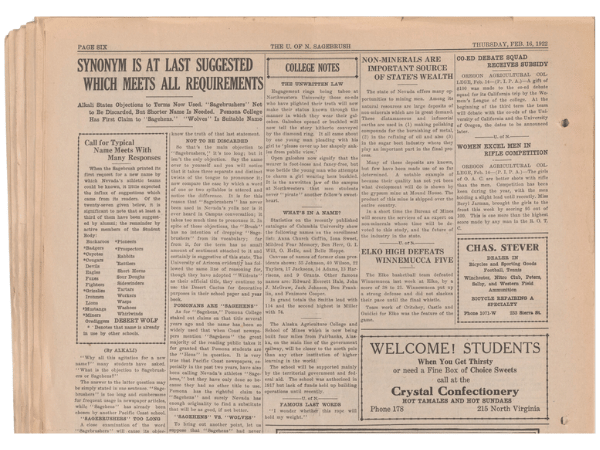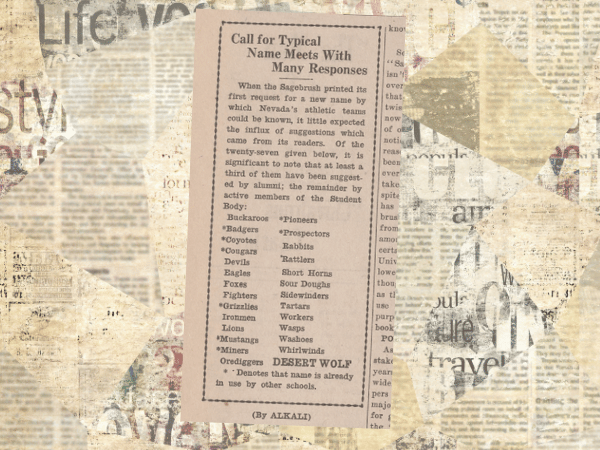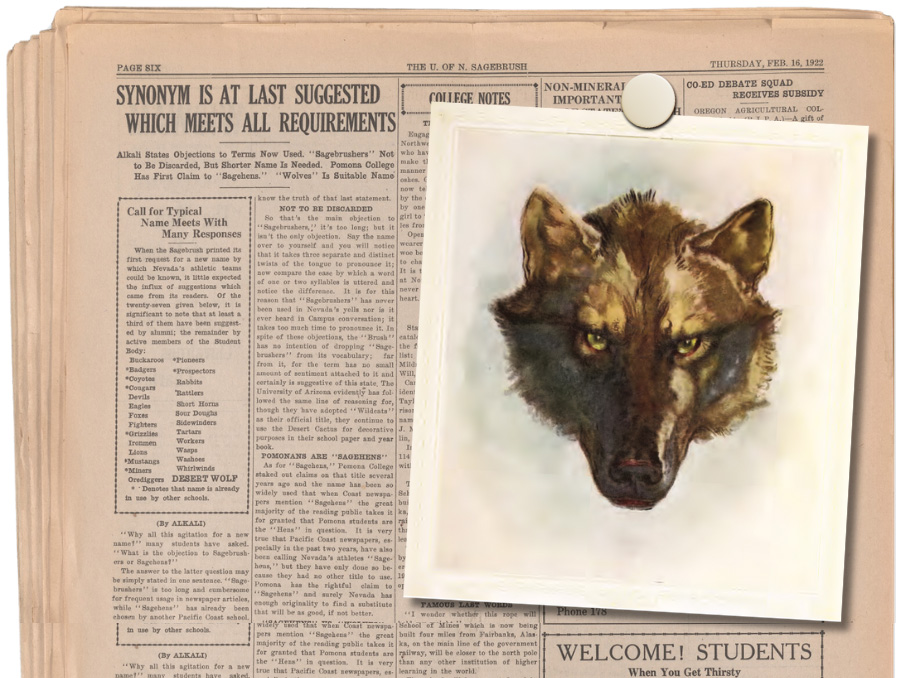The full version of this historical story was originally published in 1922 by The U. of N. Sagebrush and was brought back to life in the Nevada Silver & Blue magazine's Sesquicentennial Issue. It has been edited for length for Nevada Today.
“Why all this agitation for a new name?” many students have asked. “What is the objection to Sagebrushers or Sagehens?”
The answer to the latter question may be simply stated in one sentence. ‘‘Sagebrushers” is too long and cumbersome for frequent usage in newspaper articles, while ‘‘Sagehens” has already been chosen by another Pacific Coast school.
“Sagebrushers” too long
A close examination of the word ‘‘Sagebrushers” will cause its objectionable features to stand out clearly. To begin with, it contains twelve letters and if you will look at the one column headlines in this paper you will see that each line of the commonest-used type contains, on the average, fifteen spaces.
Now headline writing is an art in itself, so much so that the larger dailies employ men who do nothing else. Suppose a three-line head is desired for an important article; if the first line written contains fifteen spaces the two remaining lines must also contain fifteen spaces apiece or the “hed” will not balance and the general effect of the paper’s makeup will be spoiled.
Though a headline is limited as to length, yet a good one must give the general tenor of the article which follows it and when we attempt to use a word of such length as “Sagebrushers” in a headline we immediately get into hot water. The word “Sagebrushers” alone is not long enough to fill the line of type; yet, allowing for a space between words, it will be seen that a word of two or three letters, at the most, must be found to fill the first line and the remaining two must contain the general statement concerning the nature of the article which follows.
If you are skeptical about the amount of work which the use of “Sagebrushers” in a headline involves, I can only suggest a trial which I am sure will convince you of the logic of my argument.
Shorter term needed
Let us suppose that you are working on the ‘‘Brush” Staff and along about 1 a.m. the editor hands you an article which is long enough to merit a threeline head. You glance over the copy and see that it is an advance write-up on a trip which the basketball team is to take to the Coast. “Varsity” has been used so often that you are tired of it so you begin with “Sagebrushers.” You will probably progress like this: “Sagebrushers . . .?” and unless an unusually happy thought strikes you, that is just about all the progress you will make. Please don’t misunderstand me by thinking that I am trying to convince you that a headline with the word “Sagebrushers” in it is impossible to write, for a great many headlines have contained “Sagebrushers.” What I am trying to show you is that a word of half its length can be used much oftener and with much greater ease. If you will allow me, I may say that I’ve had enough experience to know the truth of that last statement.

Not to be discarded
So that’s the main objection to “Sagebrushers,” it’s too long; but it isn’t the only objection. Say the name over to yourself and you will notice that it takes three separate and distinct twists of the tongue to pronounce it; now compare the ease by which a word of one or two syllables is uttered and notice the difference. It is for this reason that “Sagebrushers” has never been used in Nevada’s yells nor is it ever heard in Campus conversation; it takes too much time to pronounce it.
In spite of these objections, the “Brush” has no intention of dropping “Sagebrushers” from its vocabulary; far from it, for the term has no small amount of sentiment attached to it and certainly is suggestive of this state. The University of Arizona evidently has followed the same line of reasoning for, though they have adopted “Wildcats” as their official title, they continue to use the Desert Cactus for decorative purposes in their school paper and yearbook.
Pomonans are “Sagehens.” As for “Sagehens,” Pomona College staked out claims on that title several years ago and the name has been so widely used that when Coast newspapers mention “Sagehens” the great majority of the reading public takes it for granted that Pomona students are the “Hens” in question.
It is very true that Pacific Coast newspapers, especially in the past two years, have also been calling Nevada’s athletes “Sagehens,” but they have only done so because they had no other title to use. Pomona has the rightful claim to “Sagehens” and surely Nevada has enough originality to find a substitute that will be as good, if not better.
“Sagehens” vs. “Wolves”
To bring out another point, let us suppose that ‘‘Sagehens” had never been adopted by another school; would we, ourselves, adopt it? I think not, for to my mind the meek and inoffensive Sagehen in no way, shape, or manner can be construed to symbolize Nevada’s fight and do-or-die determination for which her athletic teams have long been famous. Nevada’s athletes are certainly not to be compared to birds who are easy prey for every blundering hunter with a shotgun. Rather, they are to be compared to fighting, snarling, snapping, ...............(?) What?
That’s the blank we want to fill in with an appropriate name and of the many suggested, we wish to submit the following for your approval or rejection: “Desert Wolves,” which, of course, immediately resolves into into ‘‘Wolves,” for short. “Fighting, snarling, snapping Wolves”; if that doesn’t personify Nevada’s famous fight, I don’t know what does.
A Desert Wolf: Did you ever see one in his natural state? A silver grey brute of a beast, whose main characteristic is Endurance and who will fight as long as a spark of life is left in him. He will tackle an animal twice his size and as punishment only causes him to bring his reserve strength into play, he is usually the victor.
That’s a Desert Wolf and that’s Nevada’s spirit symbolized. Am I right?

Derivative from “Wolves”
If we choose “Wolves” as a synonym for our athletic teams, think of the many uses we can make of the term, and its derivatives.
Freshmen aspirants to athletic honors would be known as “Pups” or “Whelps;” team captains would be “Leaders of the Pack;” a snarling wolf’s head would be an excellent symbol to use in the University’s publications and on athletic blankets; and I can easily imagine a “Howling Wolf Yell” that would strike terror into the hearts of Nevada’s opponents on the gridiron, court, or cinder track.
Come, now, let’s hear what you think about “Wolves” for a synonym. The “Brush” will be glad to print articles supporting or rejecting this suggestion. The subject is open to discussion, go to it.














